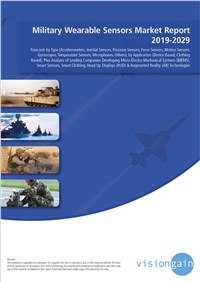Military wearable sensors are smart electronic devices which are located near, on or in the soldier’s body to provide intelligent services. These sensors incorporate various features and functions such as personal networks, sensors, C4 communications, and the power to manage the systems. Also, these devices allow for the concept of enabling the connected soldiers which will aid them during crucial operations. Portable and wearables devices are highly valuable for soldiers. Hence, there has been a growing trend and demand of wearable technologies which is the smart use of technologies to assist soldiers during military operations
The key player assesses the military wearable sensors market at $179m in 2019.
The recent developments in military wearable sensors technologies within the broader IoT ecosystem has led Visiongain to publish this timely report. The military wearable sensors market is expected to flourish in the next few years because of increasing demand for smaller and efficient sensors and a rise in development of smart clothing. If you want to be part of this growing industry, then read on to discover how you can maximise your investment potential.
- Do you need definitive military wearable sensors market data?
- Succinct military wearable sensors market analysis?
- Technological insight?
- Clear competitor analysis?
- Actionable business recommendations?
Read on to discover how this definitive report can transform your own research and save you time.
Report highlights
263 tables, charts, and graphs
Analysis of key players in military wearable sensors market players
- Analog Devices, Inc.
- Arm Holding Plc
- Arralis
- BAE Systems
- Bosch Sensortec GmbH
- Leidos
- Lockheed Martin
- Micron products
- Microsoft
- MicroVision
- Micron Products
- Q-Track
- Rheinmetall Group
- Safran Electronics & Defence
- TE connectivity
- The Boeing Company
- TT Electronics plc
Global Military Wearable Sensors Market Outlook And Analysis From 2019-2029
Military Wearable Sensors Type Forecasts And Analysis From 2019-2029
- Accelerometers Forecast 2029-2029
- Inertial Sensors Forecast 2029-2029
- Pressure Sensors Forecast 2029-2029
- Force Sensors Forecast 2029-2029
- Motion Sensors Forecast 2029-2029
- Gyroscopes Forecast 2029-2029
- Temperature Sensors Forecast 2029-2029
- Microphones Forecast 2029-2029
- Others Forecast 2029-2029
Application Segment Includes
- Clothing Based Forecast 2029-2029
- Device Based Forecast 2029-2029
Regional Military Wearable Sensors Market Forecasts From 2019-2029
North America Military Wearable Sensors Forecast 2019-2029
- US Military Wearable Sensors Forecast 2029-2029
- Canada Military Wearable Sensors Forecast 2029-2029
Asia Pacific Military Wearable Sensors Forecast 2019-2029
- Japan Military Wearable Sensors Forecast 2029-2029
- China Military Wearable Sensors Forecast 2029-2029
- India Military Wearable Sensors Forecast 2029-2029
- Australia Military Wearable Sensors Forecast 2029-2029
- Rest of APAC Military Wearable Sensors Forecast 2029-2029
Europe Military Wearable Sensors Forecast 2019-2029
- UK Military Wearable Sensors Forecast 2029-2029
- Germany Military Wearable Sensors Forecast 2029-2029
- France Military Wearable Sensors Forecast 2029-2029
- Russia Military Wearable Sensors Forecast 2029-2029
- Rest of Europe Military Wearable Sensors Forecast 2029-2029
Rest Of The World Military Wearable Sensors Forecast 2019-2029
Key Questions Answered
- What does the future hold for the military wearable sensors industry?
- Where should you target your business strategy?
- Which applications should you focus upon?
- Which disruptive technologies should you invest in?
- Which companies should you form strategic alliances with?
- Which company is likely to succeed and why?
- What business models should you adopt?
- What industry trends should you be aware of?
Target Audience




